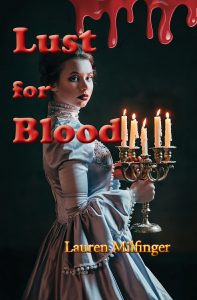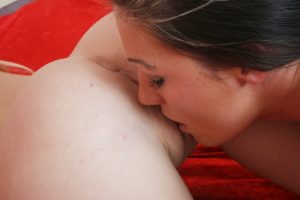I know some of you are going to be a little disappointed that there’s no incest in Lust for Blood. It started out that way, but I ended up cutting it once it became obvious that this one might just be capable of breaking out of that narrow specialist market. The cut didn’t involve that much. Just had to change where things were aimed in an early scene. Our pals at Amazon don’t seem to mind implication, but definitely frown on anything overt.
 It’s fun writing from a late Victorian viewpoint. The setting is mostly a rural estate, which means things such as electricity and telephone service have yet to make it so far from town. Rich people–the first viewpoint character’s father was an Earl, as is her brother, now that their father has passed, and the new neighbour is a Marquess–still had servants in 1895, so perhaps they didn’t miss the conveniences. Not having electricity means using gas lights and paraffin lamps, both of which are certainly more evocative of the period. Not having telephones in the countryside means that, when Lord Muntglare desperately needs to get the doctor out to the estate to care for his sister, all he can do is send a servant with the dog cart to collect him. Something that may take up to three hours.
It’s fun writing from a late Victorian viewpoint. The setting is mostly a rural estate, which means things such as electricity and telephone service have yet to make it so far from town. Rich people–the first viewpoint character’s father was an Earl, as is her brother, now that their father has passed, and the new neighbour is a Marquess–still had servants in 1895, so perhaps they didn’t miss the conveniences. Not having electricity means using gas lights and paraffin lamps, both of which are certainly more evocative of the period. Not having telephones in the countryside means that, when Lord Muntglare desperately needs to get the doctor out to the estate to care for his sister, all he can do is send a servant with the dog cart to collect him. Something that may take up to three hours.
Dog carts, by the way, which were always popular conveyances in Victorian fiction, are obviously pulled by horses, not dogs. They were two-wheeled, open carriages. The name came about because the seat was built over a ventilated compartment intended for transporting hunting dogs. Holmes and Watson seemed to spend a lot of time being hauled about the countryside in dog carts. At one point in this book Lady Anna and Suzanne stow their picnic hamper in the dog box.
I get to write as several people in this. It’s mostly diary entries, and about the only major character who doesn’t write anything is the vampire. He’s in good company there. The Count was notably silent when it came to contributing his own thoughts in Dracula, too. Lady Anna’s lady’s maid, Maureen, comes up with some good stuff. It seems she has a second identity of sorts, writing Victorian stroke books under a pen name. She’s a pretty Irish girl, obviously better-educated than most servants (she can read French, too), and sees nothing at all problematic with having lesbian sex with her mistress and her friend. She just sees it as something nice she can do and, besides, she enjoys it.
It seems she has a second identity of sorts, writing Victorian stroke books under a pen name. She’s a pretty Irish girl, obviously better-educated than most servants (she can read French, too), and sees nothing at all problematic with having lesbian sex with her mistress and her friend. She just sees it as something nice she can do and, besides, she enjoys it.
Lady Anna and Suzanne both talk about marrying, but you can tell their hearts really aren’t into it. It was just one of those things women were expected to do in the 1890s.
You really do need to read this book. It was partly inspired by a single line from Dracula, when Lucy writes to Mina, “We have slept together…” Now, I’m sure the original readers, back in 1897, were supposed to interpret that as they were roommates and slept in the same room. Me, I have a dirty mind, so I always figured those two spent a lot of time at boarding school playing at being lesbians before being graduated and settling on boring old men. That was a fairly common Victorian pornographic theme, after all. Boarding school lesbians is still a popular theme. I’m fairly sure that Lady Anna genuinely is a lesbian, knows it, and, if she ever marries at all, it will only be out of a sense of duty. Suzanne is, I suppose, sexually flexible (she fucks Lady Anna’s brother, too, after all), but seems to have a preference for women.
There’s no question at all about whether these two were getting it on in school. They roomed together, and on colds nights they slept in the same bed, naked, and obviously going at it every chance they could get. They make that quite clear. They also make it clear they started just after Suzanne’s eighteenth birthday. People in racy novels tend to wait longer than real people. And, naturally, when they get together three years after leaving school, it’s obvious that with a dozen empty bedroom in the big manor house, Suzanne will share Lady Anna’s bed. At least, until Lady Anna starts to decline and finds herself inclined to bite (there are vampires in this, remember).
Because Lust for Blood is set in 1895, and mostly consists of diary and journal entries, with a couple of newspaper clipping and letters, the language may be a bit more oblique than in my modern stories. Victorians tended to speak of “rampant masculinity,” or “that glistening pearl wherein a woman’s passion is centred,” or other slightly flowery things like that. The ladies do throw in a few “cunts” and “quims.” Hell, people, Shakespeare slipped a few “cunts” into his plays, usually as puns, so there’s precedent.

This was also a time when doctors treated “hysteria” by reaching under their patients’ voluminous skirts and masturbating them to orgasm. It was even the time when the vibrator was invented, originally as a labor-saving device for gynecologists whose fingers were cramping up dealing with throngs of hysterical women.
There was a time when hysteria was a common complaint, if only because, most of the time, the only one getting off in the marriage bed was the husband. The three ladies of Muntglare Manor are just a bit more progressive than some of their contemporaries. They’ll get each other off, and if that isn’t practical, why, they’ll take matters into their own hands, so to speak.
I suppose I should warn you, this is actually a legitimate, more or less mainstream novel with a lot of sex scenes, not a sex novel with a vampire or two. It’s not for kids, obviously, but neither is it so far out that a film producer might not be well-advised to snap it up now while the rights are still cheap.
The Kindle edition is on sale now at Amazon.com, or you can read it free if you’re a Kindle Unlimited subscriber, or want to use your monthly Prime borrow. A paperback edition is in the pipeline as well.